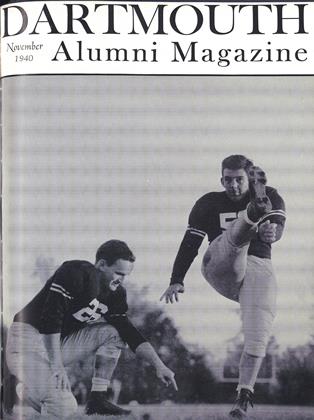IT WAS NO ACCIDENT thai the attendance at Carpenter Galleries during the col. lege year 1939-40 was fifty per cent higher than in any previous year.
Under the alert direction of a recently appointed full-time Curator, Philip White '37, the Galleries inaugurated a new phase in its program of focusing the art interests of the student body and community. This renovated policy included a broadening of the range of exhibitions to cover a wider variety of creative activity than is usually meant by the term "fine arts"; the timing of the exhibition program as effectively as possible to correlate with college courses and events of the college year; the encouragement of active student and community participation in making the shows; and the local assembly of a larger proportion of the exhibitions, rather than the renting of imported shows.
As a result, Carpenter arranged more exhibitions than in any past season of its history, and in June final figures indicated that over seven thousand students and townspeople had visited the Galleries.
While many of the shows were obtained such institutions as the American Federation of Arts and the Museum of Modern Art, the majority of them were organized by the Carpenter staff, independently or with cooperation of other departmentS.
of jjhe thirty-three separate exhibitions held only a few of the more noteworthy nn be mentioned. In November, with curious prescience, a local exhibition memorialized a city: "Paris-Its Life and Its Spirit." Rare old maps, photographs, early and modern examples of French books, colored reproductions of famous paintings interpreting the life of the city, and even a section describing French cuisine combined to give an illuminating account of its life and tempo. This survey was subsequently sent to Burlington at the request of the University of Vermont.
Most brilliant show of the year was the "Houses and Housing" exhibit which filled the galleries in January and February. First shown in Hanover on its tour around the country from the Museum of Modern Art, after it had been shown at the N. Y. World's Fair, it was augmented by six large glass photographic transparencies of modern homes donated to Dartmouth by the U. S. Housing Authority, and by an interesting table display of "Useful Objects Under Ten Dollars" revealing fine craftsmanship in various kinds of machine and hand products.
Designs submitted in the competition for the Carnival poster of 1940 enlivened the Galleries at that season, and in February the student and community photo graphic salon was also held. March saw a special exhibition of works of art owned by members of the community, which brought to public view scores of valuable paintings and prints, as well as several "American primitives" of the early days of itinerant limners.
For the first time in the annual Community Art Show, devoted to creative work by undergraduates and townspeople, a cash prize of twenty-five dollars and honorable mentions were awarded by a jury from the Art Department, the first prize going to Josh Clark '43, for his oil-painting "Queer Street." Many excellent entries for this May show were received from the nearby towns of Woodstock, Lyme and The tford, and a number of local professionals were represented.
A disappointing entry list, however, considering the number of Dartmouth graduates who paint and model, marred the Biennial Alumni Exhibition, the last event of the season, though the paintings submitted were of high quality and the works of Paul Sample '2O, Artist-in-Residence, received much favorable comment.
Throughout the appearance of these major shows were hung small teaching displays of colored reproductions and prints from the Art Department collections. Other small loan exhibits covering a wide range of historical and contemporary interests rounded out the full eight months' program.
 View Full Issue
View Full Issue
More From This Issue
-
 Article
ArticleCharles A. Proctor
November 1940 By JOHN HURD JR. '21 -
 Article
ArticleCan I Get In?
November 1940 By COREY FORD -
 Class Notes
Class Notes1926*
November 1940 By CHARLES S. BISHOP, CLARENCE G. MCDAVITT JR. -
 Class Notes
Class Notes1918*
November 1940 By ERNEST H. EARLEY, DONALD L. BARR -
 Class Notes
Class Notes1931*
November 1940 By CHARLES S. MCALLISTER, CRAIG THORN JR. -
 Class Notes
Class Notes1921*
November 1940 By CHARLES A. STICKNEY JR., ROGER C. WILDE
Robert R. Rodgers '42
-
 Letters to the Editor
Letters to the EditorLetters
OCTOBER 1985 -
 Article
ArticleJANITOR'S LIFE
December 1940 By ROBERT R. RODGERS '42 -
 Article
ArticleTONY THE BARBER
May 1941 By Robert R. Rodgers '42 -
 Article
ArticleYankee Progress and Ingenuity
December 1941 By Robert R. Rodgers '42 -
 Article
ArticlePRECAUTIONS WELL ORGANIZED IN HANOVER DEFENSE PROGRAM
February 1942 By Robert R. Rodgers '42 -
 Article
ArticleTop Television Man
June 1950 By ROBERT R. RODGERS '42
Article
-
 Article
Article"A Gentleman and a Scholar"
FEBRUARY, 1927 -
 Article
ArticleA WAH-HOO-WAH!
October 1943 -
 Article
Article30 Dartmouth Students Dressed in Green
June 1974 By W.A.G. -
 Article
ArticleAbout 25 Years Ago
October 1937 By Wared Wilkins '13 -
 Article
ArticleThayer School
June 1952 By WILLIAM P. KIMBALL '29 -
 Article
ArticleThayer School
January 1942 By William P. Kimball '29.


